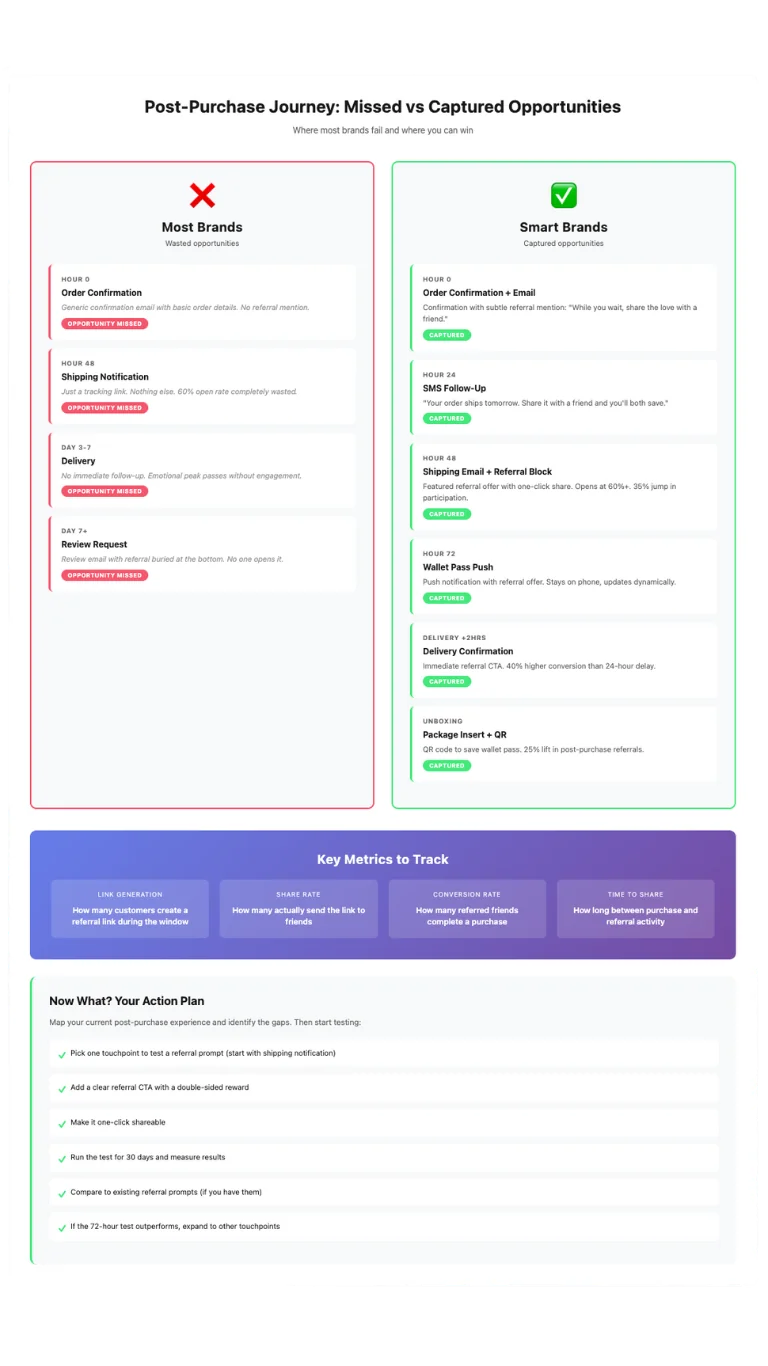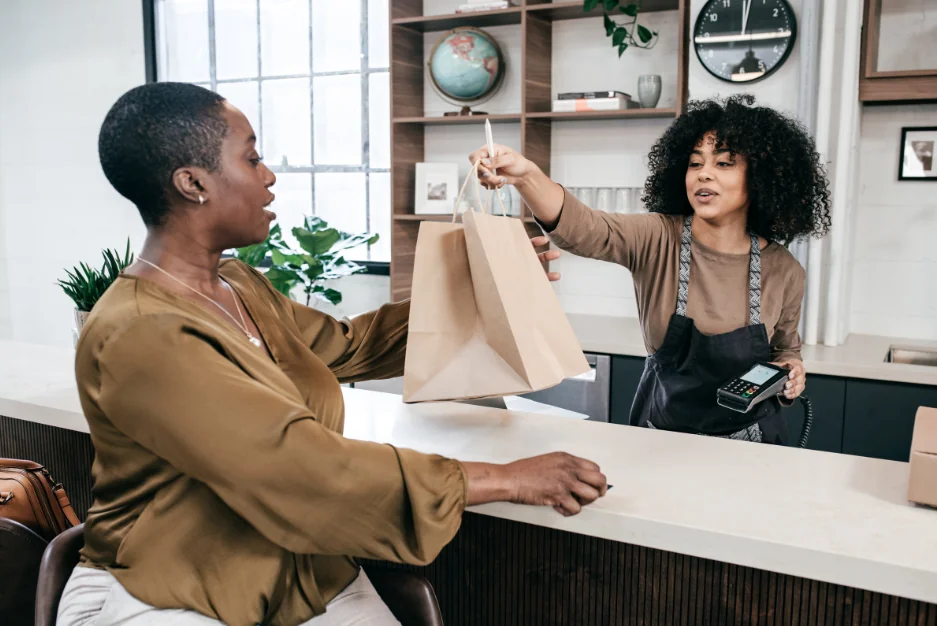The first 72 hours after a purchase are the most valuable window you have. Not just for retention. Not just for reviews. For referrals.
This is when excitement peaks. When customers are checking order confirmations, tracking shipments, and telling friends what they just bought. It’s the moment when advocacy is easiest because the purchase decision is still fresh and emotionally charged.
Yet most brands waste it. They send a generic order confirmation, a shipping notification, and maybe a review request a week later. Meanwhile, the referral prompt (if it exists at all) gets buried in an email three days post-delivery that no one opens.
Let’s fix that.
Why 72 hours matters more than you think
Customer anticipation doesn’t peak at delivery. It peaks between purchase and delivery. That’s the window when people are excited, impatient, and actively engaged with your brand.
They’re refreshing tracking pages. Opening your emails. Checking their phones for updates. Some are even posting about their purchase on social before the product arrives. This is when they’re most likely to respond to a referral prompt, not because you asked, but because they’re already in sharing mode.
The brands that win here are the ones that recognize anticipation as an emotion you can harness. And the 72-hour window is where that emotion is strongest.
Shipping notifications are wasted referral real estate
Every shipping notification you send is an open opportunity. Customers open these emails at absurd rates, often 60% or higher, because they contain information people actually want.
So why are you only using them to share a tracking link?
Here’s what works: embed a referral offer directly into the shipping notification. Not as an afterthought. As a featured moment. Frame it as a way to share the excitement, not as a sales pitch.
Something like: “Your order is on the way. Want to share the love? Give a friend 20% off and get $20 when they order.” Simple. Relevant. Timely.
One DTC brand we worked with tested this exact approach. They added a referral block to their shipping confirmation emails with a one-click share option. Referral participation jumped 35% without changing the offer or adding a single new email to the flow.
The tracking email isn’t a utility. It’s a touchpoint. Treat it like one.
Coordinating email, SMS, and wallet for maximum reach
The 72-hour window isn’t one touchpoint. It’s a sequence. And if you’re only using email, you’re missing half your audience.
Here’s the playbook: send the order confirmation via email with a subtle referral mention. Follow up 24 hours later with an SMS that says “Your order ships tomorrow. Share it with a friend and you’ll both save.” Then, if the customer has saved a wallet pass, trigger a push notification on day three with an updated referral offer.
This isn’t spam. It’s orchestration. Each channel serves a different purpose and reaches the customer in a different context. Email is detailed. SMS is immediate. Wallet is persistent.
The key is making sure each message feels native to the channel and doesn’t repeat itself. You’re not saying the same thing three times. You’re building a sequence that guides the customer from purchase excitement to advocacy action.
And yes, this works. Brands running coordinated post-purchase referral sequences see 50-70% higher share rates than brands relying on email alone.
The unboxing moment still matters
Physical products create physical moments. And the unboxing experience is one of the highest-trust, highest-emotion touchpoints in the entire customer journey.
This is where packaging inserts, QR codes, and wallet passes come into play. If someone is excited enough to open a box, they’re excited enough to share. You just need to make it easy.
A simple card in the package with a QR code that links to a referral page works. Better yet, offer a wallet pass that the customer can save directly from the insert. It stays on their phone, updates dynamically, and reminds them to share when the timing is right.
One fashion brand started including QR-coded inserts in every shipment. Customers scanned the code, saved a wallet pass, and got a referral offer that could be shared immediately or triggered later via geo-location or push. The result? A 25% lift in post-purchase referrals within 60 days.
Don’t overthink the insert design. Keep it clean, branded, and action-oriented. The goal is to get the pass saved, not to win a design award.
Using delivery confirmation as a share trigger
Delivery is the moment of truth. The product has arrived. The anticipation is over. And the customer is about to form their first real opinion about what they bought.
This is your second-best referral window (after the 72-hour anticipation phase). If the product delivers on the promise, customers are in a high-trust, high-satisfaction state. That’s when you ask.
Send a delivery confirmation that includes a referral prompt. Not buried at the bottom. Featured prominently with a clear value proposition. “Love it? Share it with a friend and you’ll both get 20% off your next order.”
Timing matters here. Send the referral prompt within a few hours of delivery, not the next day. The emotional peak is narrow. If you wait too long, the moment passes.
One home decor brand tested this exact sequence. They sent a delivery notification with a referral CTA within two hours of the product arriving. Conversion rates were 40% higher than referral prompts sent 24 hours post-delivery. Speed wins.
Avoiding the review-referral conflict
Here’s a mistake most brands make: they ask for a review and a referral at the same time. Or worse, they ask for a review first and bury the referral offer in the same email.
Don’t do that. Reviews and referrals serve different purposes and require different emotional states. Reviews ask customers to reflect and evaluate. Referrals ask them to share and advocate. Those aren’t the same thing.
Sequence them. If you’re going to ask for both, ask for the referral first (during the 72-hour window) and the review later (after the customer has used the product for a week or more). This respects the customer’s journey and maximizes response rates for both asks.
Some brands have tested inverse sequences and found that asking for reviews first actually suppresses referral activity. Why? Because the review prompt forces the customer into evaluation mode, which is less emotional and less action-oriented than advocacy mode.
Get the referral while the excitement is high. Get the review when the product has proven itself.
Measuring the 72-hour impact
If you’re going to optimize the 72-hour window, you need to know what’s working. That means tracking the right metrics.
Start with these: referral link generation rate (how many customers create a link during the window), share rate (how many actually send the link), conversion rate (how many referred friends complete a purchase), and time to share (how long between purchase and referral activity).
Layer in cohort analysis. Compare customers who refer within 72 hours versus those who refer later. Look at lifetime value, repeat purchase rates, and secondary referrals. You’ll likely find that early referrers are higher-quality customers across the board.
If your data shows that the 72-hour window outperforms later asks, double down. Shift budget and creative resources toward optimizing that sequence. Test new copy. Try different offers. Add channels.
The brands that obsess over this window are the ones seeing 3x to 5x referral ROI compared to programs that treat post-purchase as a single touchpoint.
Ok, now what?
Map your current post-purchase experience from order confirmation to delivery. Identify every customer touchpoint: confirmation email, shipping notification, delivery alert, follow-up messages. Where are the gaps?
Now, pick one touchpoint to test a referral prompt. Start with the shipping notification if you’re not using it yet. Add a clear referral CTA with a double-sided reward. Make it one-click shareable.
Run the test for 30 days. Measure referral generation rates and conversion rates. Compare it to your existing referral prompts (if you have them). If the 72-hour test outperforms, expand to other touchpoints.
The 72-hour window isn’t theory. It’s the most measurable, highest-converting referral opportunity in your entire customer journey. The only question is whether you’re using it.
About the Author:
Jeremy Foreshew is a full-stack marketer with deep expertise in customer-led growth. As Head of Marketing at Talkable, he helps DTC and eCommerce brands turn their customers into their most powerful acquisition channel. Jeremy writes about referral strategy, retention, and the future of word-of-mouth marketing. He has been featured in Forbes, TechCrunch, and HuffPost.





